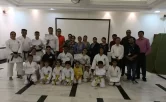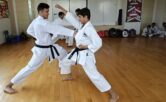The Dojo
‘Nana korobi, ya oki’
Fall down seven times, stand upon the eighth
The dojo is sacred; it is holy and the students pay their respects to the space as they enter. The old clubhouse in Raheja Estate, Borivali East resembles a sanctuary and has spiritual significance for the karatekas. It symbolizes the coming together of persons of all age groups and many professions to train as one — as students, all equal in their capacity to be the best versions of themselves, before the Shihan. The Shihan recognizes them all as warriors, winners — his motto — as he bows to each and addresses the class with an Oss.
Warmed up with exercises to increase hip mobility, the students assume the Yoi and await the Shihan’s instructions. Teaching is essentially on the basis of the syllabus and what is learnt falls into chapters. However, it is summer and as the end of a term nears, the Shihan parts from a pre-decided schedule and introduces ‘unconventionality.’ He takes up techniques that are foreign to the senior students even who are to travel to Japan for the KWF World Championship in late 2023 and therefore, undergo extensive training sessions with the Shihan regularly. Such a nuance brings the term ‘egalitarian’ to mind. The dojo is just and fair and the Shihan is the purveyor of these ideals.
The session starts off with ‘multidirectional training.’ The aim is to work on one’s vigilance and eliminate blind spots by directing punches at three opponents in minimum time and with maximal force. Close attention is paid to the rotation of hips as the Shihan guides every student to manifest maximum power into choku-zuki while keeping their stance rooted and torso free. Black belts do not line up in front of the other belts but position themselves amongst the belts so that they may be observed. It instils greater faith into them as mentors and in turn, their presence is a reassurance to others. It kindles confidence and certainty that they, too, can attain the belt with diligence.
The Shihan has a demonstration based approach to teaching and beckons to the students who gather right away and sit up straight — attentive and absorbing. He asks the black belts to assemble and they face the class in kamae. This sets an illustrative example. As the black belts carry out the techniques to be taught alongside the Shihan’s instructions and his own demo, the students have a tighter grip on the information received and are geared up to test the teachings themselves. Everything is broken down into A, B and C; there is no technical jargon. Real life experiences are given the precedence. All is simplified and it ensures that newer students and seniors absorb alike. To then be able to apply this knowledge is exciting. It is empowering and the students are enthusiastic.
The dojo caters to everyone — Karate, here, has symbiotic associations; it is taught as a sport and insights are shared into how to score points in a match, keep oneself safe from injury, appear confident before the opponent, stay calm when found in a fix, etc. It is, however, also taught as a traditional art form to soothe the psyche and have all-encompassing benefits for the individual. Karate not only builds a competitive spirit but also inculcates patience in the individual. It is not just an activity; it is a way of life. It strengthens; it heals.
The session comprises of training the eyesight also. Confidence is key and the Shihan explains to the students the importance of having a clear line of sight and approaching with the back upright in order to then strike while also working on one’s tsugi ashi and yori ashi, and learning to stay calm during times of distress. The black belts come forward to perform the same and help the students engage in observational learning. The Shihan seamlessly divides the class in trios and commands each black belt to convey the steps performed to their respective trios. This exercise is to help imbibe the values of team-building and the importance of cooperation — an opportunity presented to the senior students to test their leadership skills, therefore, fostering in them feelings of responsibility, accountability as the trios are later asked to perform separately. This simple exercise aids in inducing the importance of teamwork and deference in the junior students as well.
The definition of dojo, thus, goes beyond its preconceived understanding of simple observation and carrying out of actions; it is rather the passionate engagement with an art form and embodiment of virtues. As the session comes to an end, all the students irrespective of their belts indulge in playful banter and together with the Shihan, perform cooling down exercises in one large circle. Having worked up a sweat and made immense progress, the students begin to exit the class but not before bowing down before the dojo, the Shihan and taking a smile along.




Great write up. Good content.
Thank you!